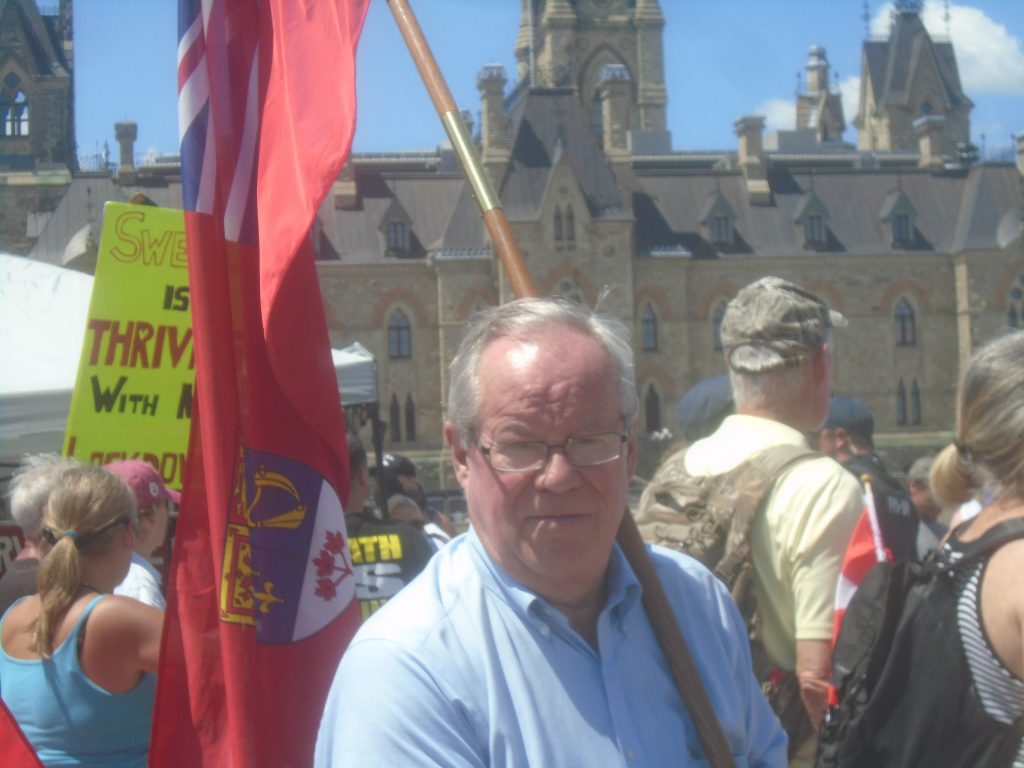Loss of Freedoms & Canada’s End the Lockdown Movement
[On May 17, the Globe and Mail published an opinion piece co-authored by Bernie Farber smearing the END THE LOCKDOWN rallies. For several days, I sought to reach the editor and Opinion Page editor of the Globe. They are unreachable by phone. I sent an e-mail proposing a rebuttal piece. I got no answer. I submitted a response which forms part of the article below. I received no answer. The Globe happily publishes smears by one of Canada’s most notorious opponents of free speech, but permits no reply. Here is the Farber hatchet job: https://www.theglobeandmail.com/opinion/article-the-overlap-between-lockdown-agitators-and-hate-groups-is-a-threat-to/]
Since mid-March, 2020, End the Lockdown rallies have been a regular weekly occurrence in cities across Canada. At first, most of the press ignored them or dismissed them, as Ontario’s Premier Doug Ford did, a “a bunch of yahoos.” However, their staying and spread across the Dominion have made them impossible to ignore.
So, many in the elite have changed their tune.
Calgary’s mayor Naheed Nenshi is a Moslem who alleges that the End The Lockdown Movement is a vast rightwing conspiracy. “They are people who are marching in thinly veiled white nationalist supremacist anti-government protests,” he said. His accusations were echoed by Jagmeet Singh, he of the rainbow coloured collection of turbans, the $2,000 suits, the BMW Coup, hailed by BuzzFeed as the “most stylish politician in Canada”. He is a supporter of the radical Sikh Khalistan movement and, in 2013, was banned from India. He heads the socialist New Democratic Party in the Dominion Parliament. Recently Singh said the protests are part of “extreme right-wing ideology.” He complained “To brazenly not follow public-health guidelines puts people at risk and that is something that we’ve seen with extreme right-wing ideology, ”
And Bernie Farber, long one of Canada’s fiercest opponents of free speech weighed in. Writing in the Globe and Mail (May 17, 2021)he alleged: “The principal actors of the anti-lockdown movement have either been or rubbed elbows with some significant haters on the scene. Vancouver neo-Nazi Brian Ruhe, Quebec’s far-right conspiracy streamer Alexis Cossette-Trudel, a big name among France’s QAnon following, is an important mouthpiece of the francophone anti-lockdown movement. Neo-Nazi Paul Fromm is a fixture at rallies in both Ontario and in Kelowna, B.C. Antimask activist Chris Saccoccia’s social-media feeds feature Holocaust denial and racist posts.” Farber was for years the CEO of the Canadian Jewish Congress, whose lobbying brought about Canada’s notorious Sec. 319 of the Criminal Code, the “hate law”. Farber lobbied mightily to have me fired from my 25-year teaching position as an English instructor in Peel County. He now heads the Canadian Anti-Hate Network (CAHN), funded by federal government grants and a huge donation from the Bank of Montreal.
The CAHN tosses around the smear “neo-Nazi” promiscuously. Farber’s fellow board member at the Canadian Anti-Hate Network Evan Balgord elaborated on the conspiracy theory: “We have two pandemics: We have the actual pandemic and then we have this pandemic of hate.Things are kind of getting worse both online and offline … with maybe one pandemic, we have kind of a solution for, but the hate thing, we don’t have a vaccine for that.” The Toronto Star (May 10, 2021) quoted Balgord: “Balgord said such events make for ‘fertile hunting’ for new recruits because hateful ideas are not being policed, and once someone believes in one conspiracy theory, it’s easy to believe in others. ‘We now have a greatly increased number of people who are coming into close contact with racists and bigots of all stripes with more conspiracy theories.'” he said.
As early as last December, Canada’s censorship lobby was sounding the alarm. The Kelowna Courier (December 18, 2020) reported: “Anti-mask and anti-lockdown rallies in Kelowna have caught the attention of anti-hate groups across Canada because of what they say are ties to a known Canadian white supremacist. According to Elizabeth Simons, deputy director of the Canadian Anti-Hate Network, the presence of Paul Fromm at several local rallies dating back to the spring, and his association with rally organizer David Kevin Lindsay, are troubling.
Fromm has been described by anti-hate groups as a known neo-Nazi. According to Simonds, far-right and white-nationalist groups and supporters are directly involved in organizing many similar rallies across Canada. ‘It’s hugely concerning seeing this trend right across the country,’ she said.”
Jewish lobby groups have, in the past, been adept at “divide and conquer”, decreeing who may associate with whom or meet with whom without being tainted.
However, with Canada’s End the Lockdown movement, the old tactic is just not working. That’s because of the nature of the movement, as I shall explain. If the End the Lockdown movement is not a vast rightwing conspiracy, then what is it? As they say on the dating sites: “It’s complicated.”
On May 17, the Globe ran an opinion piece by Bernie Farber and David Fisman entitled “Overlap between lockdown agitators and hate groups is a threat to us all” which caricatured the END THE LOCKDOWN rallies that have occurred on a weekly across the Dominion.
A reader, uninformed by information available on the Internet or his own experience at a local rally, might conclude these rallies comprised people strutting around in funny armbands or earnest conspiracy weirdos with tinfoil hats. Nothing could be further from the truth.
Attend one of these rallies and, although the attendees are angry at the job killing lockdowns, and the loss of freedom to gather to worship, you find a happy atmosphere, reminiscent of a 60s love-in. Far from being a “hate group”, these rallies are joyous events, often with people dancing to boom box music and songs like Twisted Sister’s “We’re not gonna take it anymore” or Rolling Stones Mick Jagger’s new anti-lockdown song “Easy Sleazy”. No one wears a mask — well, occasionally, some wit wears one of those mediaeval doctor’s masks that looks like a bird’s beak. People embrace and hug complete strangers. Everyone is welcome. Indeed, one of the groups participating in many rallies is called Hugs Over Masks. In Toronto, a Chinese lady circulates through the crowd offering a tray of her home-baked treats free to fellow “freedom fighters.” Sadly, this elegant lady, in high heels and a fashionable dress, was handcuffed and arrested on May 8 for being in possession of a megaphone.
The END THE LOCKDOWN rallies are a political protestof a sort unseen since World War II. They started in Vancouver in mid-March 2020 The next weekend, they spread to Toronto. Those calling for an end to the crippling lockdown were sniffily dismissed by Premier Ford as “a bunch of yahoos”. Ironically, many of these people had been part of his populist “Ford Nation.”
Since then, the rallies have spread right across the country. The remarkable fact about these protests is their regularity and consistency. They occur weekly in cities large and small. Movements in the past have staged mass rallies but not weekly and not right across the country. In the late ’60s, the left organized large anti-war demonstrations in major cities opposing the war in Vietnam twice a year. Similarly, in the mid-80s, the left staged large demonstrations against President Reagan’s star wars programme. Although these demonstrations were large, they were not weekly. Other groups have organized large protests but only on occasion like Right to Life’s annual pro-life rally in Ottawa and demonstrations against specific legislation like more stringent gun control.
The consistency and persistence of the END THE LOCKDOWN rallies are remarkable and they have spread and become a weekly occurrence from Kelowna to Penticton to Kamloops to Calgary to Edmonton to Fort McMurray to Saskatoon to Brantford and many other places. These rallies are really like ’60s “happenings.” The word goes out, usually over the Internet and concerned people show up, often with little advance notice and usually with little media attention. For instance, on May 14, over an estimated 50,000 END THE LOCKDOWN supporters gathered in Queen’s Park and heard speakers like Maxime Bernier, leader of the populist People’s Party of Canada. The rally and Mr. Bernier’s message went all but uncovered in the mainstream media. That evening, a smaller demonstration estimated at about 5,000 people supporting Palestine had sporadic clashes with a smaller group supporting Israel at Nathan Phillips Square. That was the event that got all the media attention.
Participants hail from a wide range of backgrounds. I have talked to participants who voted Liberal, NDP, Green, Conservative or People’s Party in the last election. Mr. Farber, who, I suspect, has never attended an END THE LOCKDOWN rally, alleges participants are dedicated to “an anti-public health agenda aimed at undermining the Canadian economy and the health and well-being of Canadians”.
What unites these people, young and old, working class, middle-class, rural, urban, is a passionate attachment to freedoms they see being vacuumed away in government lockdowns and restrictions. Far from undermining the economy, they want the economy re-opened and the job and business crippling lockdowns ended, perhaps like the state of Florida which is wide open, with businesses open and no enforced mask mandate and an infection rate slightly lower than Ontario, which has been locked down since November.
Some from the start some feared that enforced masking was a dry run for forced vaccination. Now, there is widespread talk of some sort of proof of vaccination being a requirement for air travel, attendance at sporting event or entry to certain jobs.
Many are appalled by the loss of religious freedom. Three Alberta pastors have been handcuffed and jailed for holding Sunday services. Yes, in Alberta, not North Korea. A ban or severe limitation on gatherings essentially cancelled Christmas and Easter worship. Religious folk and many civil libertarians are horrified at the padlocking of defiant Christian churches as has happened to Pastor Henry Hildebrandt’s in Aylmer and Pastor James Coates’ in Edmonton.
The essential spirit of the END THE LOCKDOWN rallies was captured at a mass protest on a scorching July 1, Canada Day, on Parliament Hill. A sea of Canadian flags and some old Red Ensigns is one section set up a booming chant of “Freedom, Freedom” to be answered by a sea of Quebec Fleur de lys flags and a few flags from the Revolution of 1837 in another section and their chant “liberte, liberte”. — Paul Fromm
groups participating in many rallies is called Hugs Over Masks. In Toronto, a Chinese lady circulates through the crowd offering a tray of her home-baked treats free to fellow “freedom fighters.” Sadly, this elegant lady was handcuffed and arrested on May 8 for being in possession of a megaphone.
The END THE LOCKDOWN rallies are a political protest unseen since World War II. They started in Vancouver in mid-March 2020 The next weekend, they spread to Toronto. Those calling for an end to the crippling lockdown were sniffily dismissed by Premier Ford as “a bunch of yahoos”. Ironically, many of these people had been part of his Ford Nation.
Since then, the rallies have spread right across the country. The remarkable fact about these protests is their regularity and consistency. They occur weekly in cities large and small. Movements in the past have staged mass rallies but not weekly and right across the country. In the late ’60s, the left staged large anti-war demonstrations in major cities opposing the war in Vietnam twice a year. Similarly, in the mid-80s, the left staged large demonstrations against President Reagan’s star wars programme. Although these demonstrations were large, they were not weekly. Other groups have staged large protests but only on occasion like Right to Life’s annual pro-life rally in Ottawa and demonstrations against specific legislation like more stringent gun control.
The consistency and persistence of the END THE LOCKDOWN rallies are remarkable and they have spread and become a weekly occurrence from Kelowna to Penticton to Kamloops to Calgary to Edmonton to Fort McMurray to Saskatoon to Brantford and many other places. These rallies are really like ’60s “happenings.” The word goes out, usually over the Internet and concerned people show up, often with little advance notice and usually with little media attention. For instance, on May 14, over an estimated 50,000 END THE LOCKDOWN supporters gathered in Queen’s Park and heard speakers like Maxime Bernier. The rally and Mr. Bernier’s message went all but uncovered in the mainstream media. That evening, a smaller demonstration estimated at about 5,000 people supporting Palestine had sporadic clashes with a smaller group supporting Israel at Nathan Phillips Square. That was the event that got all the media attention.
Participants hail from a wide range of backgrounds. I have talked to participants who voted Liberal, NDP, Green, Conservative or People’s Party in the last election. Mr. Farber, who, I suspect, has never attended an END THE LOCKDOWN rally, alleges participants are dedicated to “an anti-public health agenda aimed at undermining the Canadian economy and the health and well-being of Canadians”.
What unites these people, young and old, working class, middle-class, rural, urban, is a passionate attachment to freedoms they see being vacuumed away in government lockdowns and restrictions. Far from undermining the economy, they want the economy re-opened and the job and business crippling lockdowns ended, perhaps like the state of Florida which is wide open, with businesses open and no enforced mask mandate and an infection rate slightly lower than locked down Ontario.
Some from the start some feared that enforced masking was a dry run for forced vaccination. Now, there is widespread talk of some sort of proof of vaccination being a requirement for air travel, attendance at sporting event or entry to certain jobs.
Many are appalled by the loss of religious freedom. Three Alberta pastors have been handcuffed and jailed for holding Sunday services. Yes, in Alberta, not North Korea. A ban or severe limitation on gatherings essentially cancelled Christmas and Easter worship. Religious folk and many civil libertarians are horrified at the padlocking of defiant Christian churches as has happened to Pastor Henry Hildebrandt in Aylmer and Pastor James Coates in Edmonton.
The essential spirit of the END THE LOCKDOWN rallies was captured at a mass protest on a scorching July 1, Canada Day, on Parliament Hill. A sea of Canadian flags and some old Red Ensigns is one section set up a booming chant of “Freedom, Freedom” to be answered by a sea of Quebec Fleur de lys flags and a few flags from the Revolution of 1837 in another section and their chant “liberte, liberte”. — Paul Fromm



